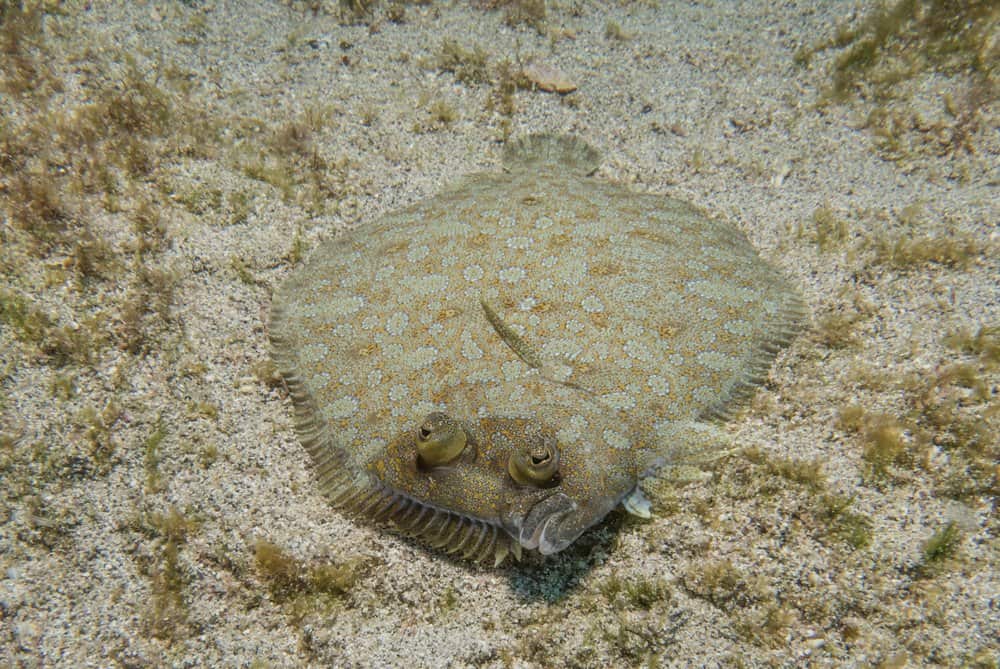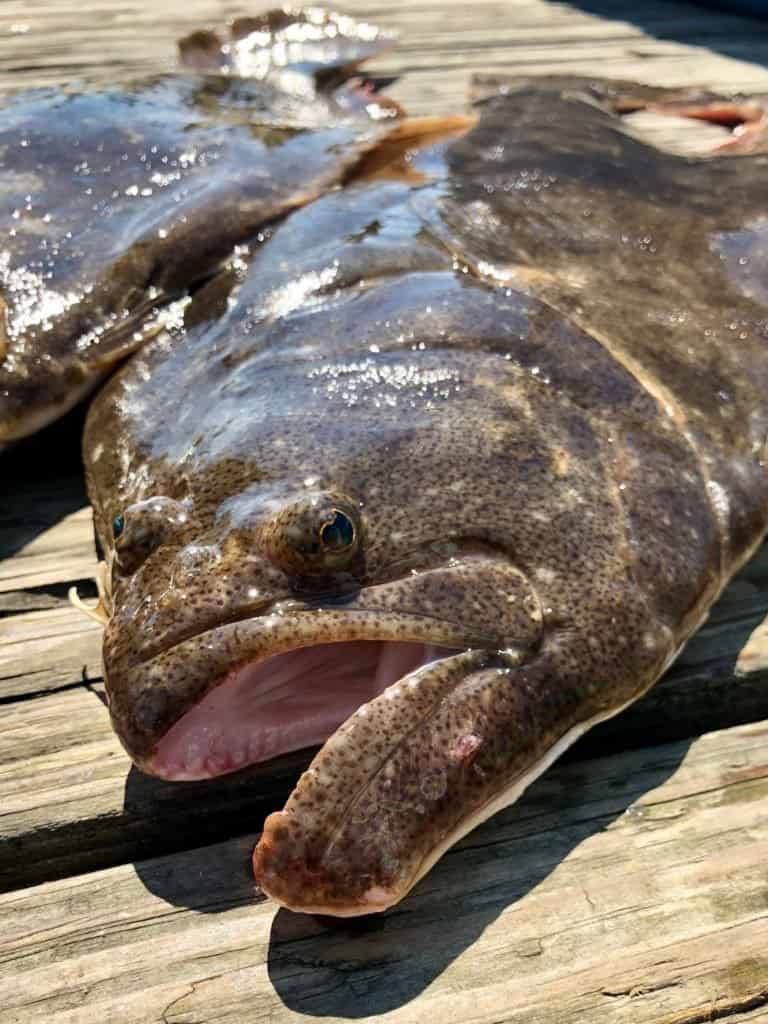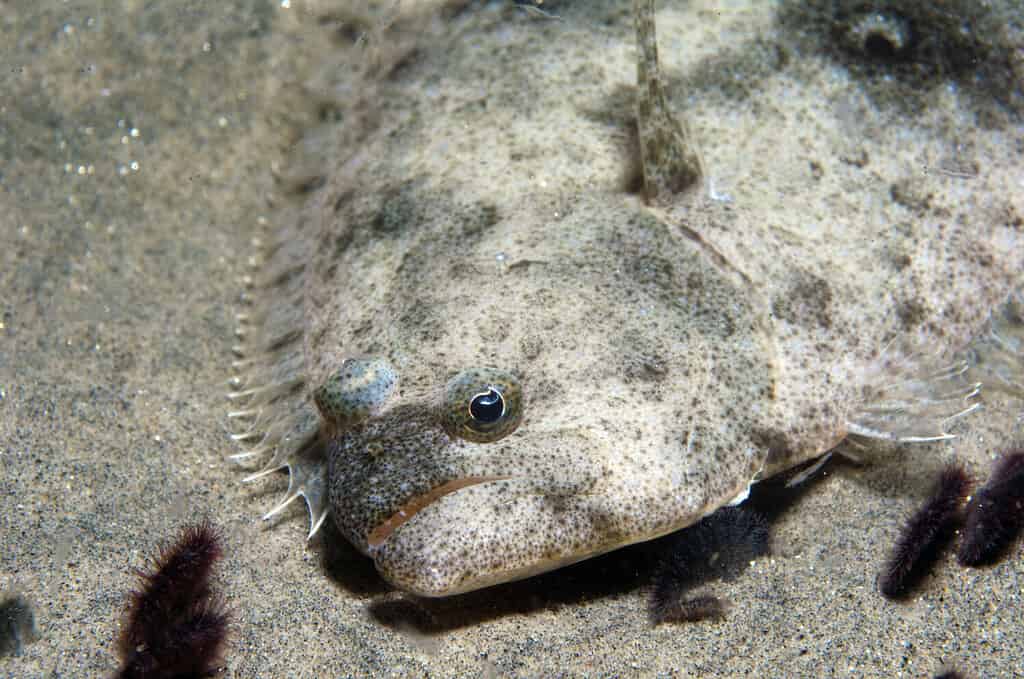Sole and flounder are flatfish that share an extraordinary trait. These creatures have an asymmetry that’s unique in the animal world. They’re born like other fish, an eye on either side of their head. But, as they mature the bones in their head start to twist and one eye begins to migrate positions. It meets the other eye so that they are both on one side of the fish’s head.
They begin to swim about in a tilted manner and their eyeless side starts to lose its coloring. The side with both eyes begins to take on a patterned coloration to blend with the ocean floor. After metamorphosis, these fish no longer swim in the water column with their symmetrical neighbors. They settle to the bottom of the ocean with their eyes facing up where they’ll live as bottom-feeders for the remainder of their lives. While these flatfish share some pretty fascinating features they also have many differences. Let’s take a look at sole vs flounder and find out what sets these quirky creatures apart.
Comparison of Sole vs Flounder

| Sole | Flounder | |
|---|---|---|
| Classification | Soleidae | Achiropsettidae, Pleuronectidae, Paralichthyidae and Bothidae |
| Habitat | North & East Atlantic, Indian Ocean, West & Central Pacific, Africa, southern Asia, Australia and New guinea | Europe, North America, Africa and Asia |
| Eye Placement | Mostly “righteye” | “righteye” and “lefteye”, depending on species |
| Culinary Use | Dover Sole are firm and fine-flaked, highly esteemed | Flounder are sweet, mild, delicate and thick-flaked |
Key Differences Between Sole and Flounder

Flounder is a popular recreational fish on the eastern seaboard of North America.
©IrinaK/Shutterstock.com
The main differences between sole and flounder are in classification, habitat, eye placement, and culinary value.
When Europeans came to the Americas they called many flounder fish soles because they looked like the fish they’d known in Europe. This has led to a lot of confusion over time. The Dover sole is the only true sole typically available commercially. It isn’t found in North America, so fish marketed as sole in North America are often flounder species. Although similar in taste, the Dover sole is of finer quality than most flounder for culinary use.
Classification of Sole and Flounder

Soles have complicated scientific classification with many animals named ‘sole’ falling into the flounder family.
©Pablo Joanidopoulos/Shutterstock.com
Sole and flounder are flatfish that fall within the order Pleuronectiformes. The true soles are of the family Soleidae, and the majority fall within this category. The species name for the true sole – the Dover sole – which is only found in the North Atlantic and Mediterranean seas, is Solea solea. Also called the common sole or black sole, it’s the largest fish in the Solea genus. The American soles used to be classified within the same family but now they have their own separate family called Achiridae. To further complicate things, several flounder species in the Pacific are called soles, such as the Pacific Dover Sole (Microstomus pacificus) and the Yellowfin sole (Limanda aspera).
Flounder is the general name for a variety of flatfish within the Pleuronectiformes order. They’re categorized into the distinct families of Achiropsettidae, Pleuronectidae, Paralichthyidae, and Bothidae. Some common flounder species include the Gulf flounder (Paralichthys albigutta), Summer flounder (Paralichthys dentatus), Witch flounder (Glyptocephalus cynoglossus) and halibut (Hippoglossus stenolepsis). The Pacific Dover sole (Microstomus pacificus) adopted the name of the European Dover sole, but it is actually a flounder species.
The summer flounder is especially popular in fishing and is often called the ‘fluke fish‘ on the East Coast of the United States.
Sole vs Flounder Habitat

Dover sole is only found in the Atlantic, while flounder species live along the coasts of Europe, North America, Africa, and Asia
©Becky Gill/Shutterstock.com
Sole are bottom-dwellers that feed on the ocean floor. They’re able to camouflage in order to match the surrounding habitat. Most prefer shallow water of temperate and tropical seas. However, some venture into deeper water. The best sole for culinary use comes from the deep Atlantic. Species from the Solidae family live in the North and East Atlantic, Indian Ocean, and West and Central Pacific ocean. Africa, southern Asia, Australia, and New Guinea are home to freshwater species. The American sole inhabits the freshwater and saltwater habitats of the Americas. The Dover Sole only lives in the Eastern Atlantic seas.
Also bottom-dwellers, the flounders are masters of disguise like the sole. They’re able to change their coloration rapidly. Sand flounders burrow almost entirely in sand or soft mud, making them virtually invisible. Tropical and temperate waters along the coasts of Europe, North America, Africa, and Asia are the main zones where these flat-finned fish find a home, with some species reaching north into the Arctic. They tend to prefer the shallow zones.
Sole vs Flounder Appearance
Sole and flounder are both flat-bodied fish that have eyes on one side of their head. Their bodies are oval-shaped but flounders bodies are generally a bit more rounded than sole species. The main distinction in their appearance is the side their eyes fall on. Most soles have eyes on the right side of their head and therefore dwell with their left sides on the ocean floor. The flounder exhibits more variety, with the eye side varying depending on the species. Flounders within the family Pleuronectidae are “righteye flounders,” because they lie on the seafloor on their left with their eyes on the right side. The Paralichtyidae family are “lefteye flounders,” with both eyes on the left side.
Sole vs Flounder in Cuisine

While flounder is flaky and delicate, Dover sole is firm and meaty and holds together well when prepared as a whole fish
©Shutterstock Media/Shutterstock.com
The Dover sole is typically the only authentic sole available commercially and is considered superior to flounder and “sole” filets in taste and texture. There’s been interest in farming this valuable species. However, according to an article in Aquaculture, attempts haven’t been successful as they’ve shown low growth rates and high susceptibility to disease. It has a firm, meaty, small-flaked flesh and holds together well in a pan. It holds a sweet and delicate flavor and aroma of the sea. Dover sole is best prepared as a whole fish because it will retain its flavor and juiciness in a way that filets cannot.
Flounder fillets are also typically sweet, flaky, and mild. All species have an incredibly delicate texture. They’re very versatile and you can prepare them in many ways as long as you respect their delicate texture. The most popular methods include broiling, baking, steaming, deep-frying, or pan-frying. If grilling, make sure to wrap the filets in foil so that fine flakes don’t crumble and fall into the grates. Some common choices of flounder species to prepare are the winter flounder (also known as Lemon Sole), the summer flounder (known as fluke), the witch flounder (also known as grey sole), the gulf flounder, and the peacock flounder.
Is Sole and Halibut the Same?

Flounder is often the general term used for all flatfish, including halibut and sole, but they are two different species.
©Greg Amptman/Shutterstock.com
Sole and halibut both belong to the family of flatfish in the order Pleuronectiformes. Flounder is often the general term used for all flatfish, but they each are their own species, with separate names, characteristics, and appearances. Sole and halibut may look the same, and they may even taste similar, but they are different fish.
Halibut is used to describe three different types of right-eyed flatfish in the genera Hippoglossus and Reinhardtius. These three types are Atlantic halibut (Hippoglossus hippoglossus), Pacific halibut (Hippoglossus stenolepis), and Greenland halibut (Reinhardtius hippoglossoides). Sole belongs to the Soleidae family, which is the family of true soles, and contains a genera of 30 and over 180 species.
The photo featured at the top of this post is © IrinaK/Shutterstock.com
Thank you for reading! Have some feedback for us? Contact the AZ Animals editorial team.






